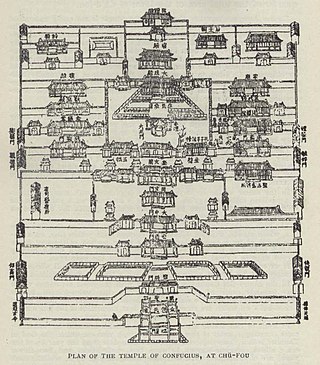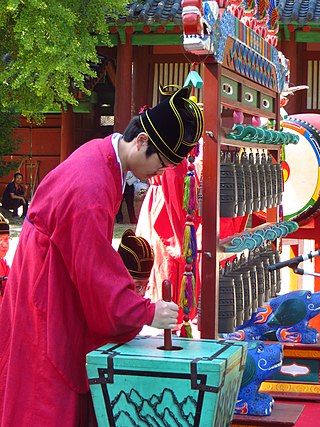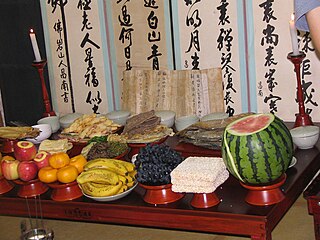
| Zhu | |||||||||
|---|---|---|---|---|---|---|---|---|---|
 Zhu in seal script | |||||||||
| Chinese | 柷 | ||||||||
| |||||||||
The zhu is an idiophonic percussion instrument that was used in yayue ,the ritual music of ancient China's Zhou dynasty.

| Zhu | |||||||||
|---|---|---|---|---|---|---|---|---|---|
 Zhu in seal script | |||||||||
| Chinese | 柷 | ||||||||
| |||||||||
The zhu is an idiophonic percussion instrument that was used in yayue ,the ritual music of ancient China's Zhou dynasty.
The zhu is a wooden box,typically painted red or otherwise decorated,that tapers from top to bottom.
The zhu is played by grasping a wooden stick and using it to strike the top of the zhu's inner bottom surface.
In antiquity,the zhu was used to mark the beginning of a piece of music. This contrasted with the tiger-shaped yu,played by striking the top of its head and crossing the ridges along its back,used to mark the end of the music. Both instruments appear in Zhou-era annals and the Classic of History [1] but are now rarely used,with surviving examples usually simply displayed in museums and Confucian temples. The Classic of Music that instructed creation and use of the yayue instruments is almost entirely lost,and aspects of modern construction and performance are guesswork or replacement. Nonetheless,a few temples—including the main Taiwan Confucian Temple —still use them for Confucian ceremonies. [2]
The Korean chuk is essentially identical to the zhu and continues to be used in Korean ritual music. Unlike many Chinese reconstructions of the zhu,which are typically open at the top,the chuk is frequently covered and the performer strikes the bottom of the instrument through a hole for that purpose.

A wooden fish,also known as a Chinese temple block,wooden bell,or muyu,is a type of woodblock that originated from East Asia that is used by monks and lay people in the Mahayana tradition of Buddhism. They are used by Buddhist ceremonies in China,Korea,Japan,Vietnam and other Asian countries. They may be referred to as a Chinese block,Korean block or,rarely,as a skull.

Korean court music comprises three main musical genres:aak,an imported form of Chinese ritual music;a pure Korean form called hyangak;and a combination of Chinese and Korean styles called dangak.
Gagaku is a type of Japanese classical music that was historically used for imperial court music and dances. Gagaku was developed as court music of the Kyoto Imperial Palace,and its near-current form was established in the Heian period (794-1185) around the 10th century. Today,it is performed by the Board of Ceremonies in the Tokyo Imperial Palace.
AakKorean pronunciation: [a.ak] is a genre of Korean court music. It is an imported form of the Chinese court music yayue,and means "elegant music". Aak was performed almost exclusively in state sacrificial rites,and in the present day it is performed in certain Confucian ceremonies.

The guqin is a plucked seven-string Chinese musical instrument. It has been played since ancient times,and has traditionally been favoured by scholars and literati as an instrument of great subtlety and refinement,as highlighted by the quote "a gentleman does not part with his qin or se without good reason," as well as being associated with the ancient Chinese philosopher Confucius. It is sometimes referred to by the Chinese as "the father of Chinese music" or "the instrument of the sages". The guqin is not to be confused with the guzheng,another Chinese long stringed instrument also without frets,but with moveable bridges under each string.

The se is an ancient plucked zither of Chinese origin. It varied in size and construction,but generally had 25–50 strings with moveable bridges and a range of up to five octaves. It was one of the most important stringed instruments in China,along with the qin. The se gradually faded out of use,having evolved into the similar zheng. Modern versions of the se often resemble the zheng,and attempts have been made to revive the instrument.

Bianzhong is an ancient Chinese musical instrument consisting of a set of bronze bells,played melodically. China is the earliest country to manufacture and use musical chimes. They are also called Chime Bells. These sets of chime bells were used as polyphonic musical instruments and some of these bells have been dated at between 2,000 to 3,600 years old. They were hung in a wooden frame and struck with a mallet. Using a wooden hammer and a rod to beat the bronze bell can make different pitch. Along with the stone chimes called bianqing,they were an important instrument in China's ritual and court music going back to ancient times.

Yayue was a form of classical music and dance performed at the royal court and temples in ancient China. The basic conventions of yayue were established in the Western Zhou. Together with law and rites,it formed the formal representation of aristocratic political power.

A temple of Confucius or Confucian temple is a temple for the veneration of Confucius and the sages and philosophers of Confucianism in Chinese folk religion and other East Asian religions. They were formerly the site of the administration of the imperial examination in China,Korea,Japan and Vietnam and often housed schools and other studying facilities.

Traditional Korean musical instruments comprise a wide range of string,wind,and percussion instruments. Many traditional Korean musical instruments derive from Chinese musical instruments.

Munmyo is Korea's primary temple of Confucius. It is located in central Seoul,South Korea,on the campus of Sungkyunkwan University.

The yu is an idiophonic tiger-shaped percussion instrument that was used in yayue,the ritual music of ancient China's Zhou dynasty.

The chuk is a traditional Korean musical instrument used in Confucian (Munmyo) and Royal Ancestral Shrine (Jongmyo) ceremonies to signal the beginning of a ritual music performance. It is played at the beginning of music,meaning that the music begins by opening the sky and the ground. It consists of a square wooden box,played by striking the bottom with a mallet to mark beats or sections. The chuk is derived from the Chinese zhu,and was imported from China during the Goryeo Dynasty.

Jesa is a ceremony commonly practiced in the East Asian cultural sphere. Jesa functions as a memorial to the ancestors of the participants. Jesa are usually held on the anniversary of the ancestor's death. The majority of Catholics,Buddhists and nonbelievers practice ancestral rites,although Protestants do not. The Catholic ban on ancestral rituals was lifted in 1939,when Pope Pius XII formally recognized ancestral rites as a civil practice. Many Korean Christians,particularly Protestants,no longer practice this rite. Christians generally,and Muslims avoid the rites,and many emigrants avoid the rites.

Shenyi,also called Deep garment in English,means "wrapping the body deep within the clothes" or "to wrap the body deep within cloth". The shenyi is an iconic form of robe in Hanfu,which was recorded in Liji and advocated in Zhu Xi's Zhuzi jiali《朱子家禮》. As cited in the Liji,the shenyi is a long robe which is created when the "upper half is connected to the bottom half to cover the body fully". The shenyi,along with its components,existed prior to the Zhou dynasty and appeared at least since the Shang dynasty. The shenyi was then developed in Zhou dynasty with a complete system of attire,being shaped by the Zhou dynasty's strict hierarchical system in terms of social levels,gender,age,and situation and was used as a basic form of clothing. The shenyi then became the mainstream clothing choice during the Qin and Han dynasties. By the Han dynasty,the shenyi had evolved into two types of robes:the qujupao and the zhijupao. The shenyi later gradually declined in popularity around the Wei,Jin,and Northern and Southern dynasties period. However,the shenyi's influence persisted in the following dynasties. The shenyi then became a form of formal wear for scholar-officials in the Song and Ming dynasties. Chinese scholars also recorded and defined the meaning of shenyi since the ancient times,such as Zhu Xi in the Song dynasty,Huang Zongxi in the Ming dynasty,and Jiang Yong in the Qing dynasty.

Tigers have been of great importance in Chinese culture since the earliest surviving records of Chinese history,with the character 虎 appearing on the Shang-era oracle bones. In prehistoric China,the Siberian,South China,and Bengal tigers were common in the northeast,southeast,and southwest respectively and tigers figures prominently in myth,astrology,Chinese poetry,painting,and other fields. Most prominently,the tiger has long been regarded as a major symbol of masculine yang energy and the king of the animals. In modern China,it generally represents power,fearlessness,and wrath.

Pingtan,also known as Suzhou pingtan,is a regional variety of quyi and a musical/oral performance art form popular in southern Jiangsu,northern Zhejiang,and Shanghai. It originated in the city of Suzhou. It is a combination of the Chinese narrative musical traditions pinghua and tanci. It dates back to Song dynasty and is influenced by Wuyue culture.

The Seokjeon Daeje,also sometimes called Seokjeonje,is a ceremonial rite performed twice annually to honor Confucius. It is held at Confucian sites across South Korea including hyanggyos and the Confucian temple Munmyo located at Sungkyunkwan,on Confucius' birthday in fall and the anniversary of his death in spring. Seokjeon is made up of the two Chinese characters,釋and 奠(alcohol),and Seokjeon Daeje means "Laying out offerings ceremony". It involves an elaborate ceremony with sacrificial offerings of alcohol and foods,as well as an elaborate dance known as munmyo ilmu accompanied by musical performances munmyo jeryeak.

Religious Confucianism is an interpretation of Confucianism as a religion. It originated in the time of Confucius with his defense of traditional religious institutions of his time such as the Jongmyo rites,and the ritual and music system.

The Chinese ritual and music system is a social system that originated in the Zhou Dynasty to maintain the social order. Together with the patriarchal system,it constituted the social system of the entire ancient China and had a great influence on the politics,culture,art and thought of later generations. The feudal system and the Well-field system were two other institutions that developed at that time. According to legend it was founded by the Duke of Zhou and King Wu of Zhou.